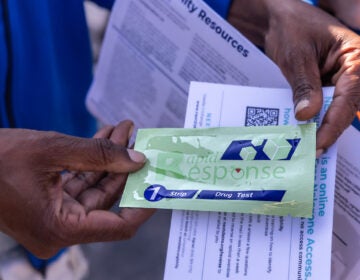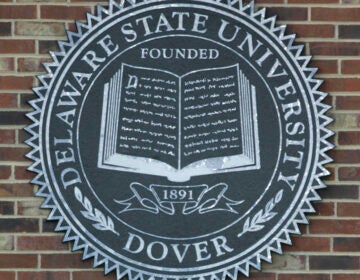Delaware congressman discusses higher education affordability

(Shana O'Malley/for NewsWorks)
Is there a way to make college more affordable? Delaware Congressman John Carney hosted a roundtable discussion with education specialists from across the state to find out.
The meeting comes in the wake of congress arguing over federal student loan interest rates and students protesting outside offices of private student loan providers while the cost of college continues to grow.
In the past three decades college costs have ballooned 570 percent while the U.S. student loan debt is more than $1 trillion.
Among the panel were representatives from public, private and charter high schools as well as a representative from Delaware State University and parents from Delaware PTA. The panel expressed that information about the cost of college as well as ways to pay for higher education is complicated and hard for parents and students to understand.
“We have a lot of students in our state whose parents never went to college so they don’t have any idea what to do,” explained Yvonne Johnson with Delaware PTA. Johnson said she was a “very involved” parent when it came to getting her daughter into college and even with her background in education it was still a struggle to find affordable ways to pay for school.
“It’s a fulltime job to get your kid into college,” said Johnson.
They also noted that many families aren’t getting involved in college planning until a student’s junior or senior year of high school, which means they’re missing out on scholarship and grant money opportunities that usually require a lot of preparation.
“Parents need to know those numbers early in the process,” said Amanda Gonye with the Delaware PTA. “Not when their kid has already applied or not when you don’t have enough time to visit other schools that really can afford to meet those scholarship deadlines. Every school does things so differently; it’s so difficult to keep a handle on all of those deadlines and requirements.”
Many of the families that do manage to get their kids into college face a long, hard financial road ahead of them, according to Doryann Barnhardt, financial aid specialist at DSU.
“You could realistically see a family who makes around $50,000 a year, borrow a parent-plus loan which is a federal loan that the U.S. Department of Education lends to parents at maybe $21,000 or $22,000 a year. If you spread that out over four years, which we hope most students will graduate in, by the time their student is done, they’re looking possibly $80,000 of their own debt in addition to the debt that their student has taken on at pretty high and not very competitive interest rates.”
Additionally, many students are forced to quit college due to a lack of funds. “One of our biggest issues is retention which is how many students come back for a second year and we saw a significant drop in our retention from over 70 percent to just above 60 percent in one year and the reason for that was the students cannot afford it,” explained Barnhardt.
Congressman Carney said the feedback he received helps him better understand the struggles families face when paying for college.
“Parents and families come in with not a lot of information about the costs and in some cases, get themselves into situations that are just not affordable,” said Carney. “So from a federal policy perspective, we have to think of ways that we can better formulate policy to address the need of affordability for each individual family so that we can make access and success more of a reality for those students.”
The meeting was the first in a series of higher education discussions the congressman has planned.
WHYY is your source for fact-based, in-depth journalism and information. As a nonprofit organization, we rely on financial support from readers like you. Please give today.




